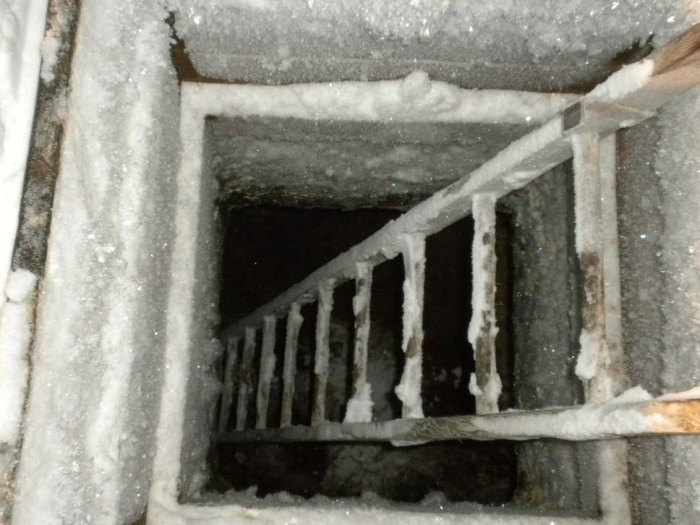Dozens of the naturally refrigerated food shelters exist underneath the region’s mainly Inupiat whaling villages, where many rely on hunting and fishing to eat.
But now climate change and other modern factors are forcing changes to an ancient way of life, rendering traditional storage methods dangerously unreliable.
Ranging from small arctic root cellars to spacious, wood-lined underground chambers, ice cellars are typically stocked with vast amounts of whale, walrus, seal and caribou.
These chambers, usually built 10 to 12 feet below the surface, have long been used to age subsistence food to perfection and ensure a steady supply during the sparser months, which is critical for survival.
But increasingly, these cellars are beginning to collect mould and water, in some cases becoming completely submerged. Others collapse completely.
In Alaska’s northernmost community, Utqiagvik – which saw its warmest summer on record this year – about 60 per cent of the 1,500 households rely on subsistence foods for at least half of their diet, National Geographic wrote in 2015.
“I’m worried,” said Gordon Brower, a Utquiagvik whaling captain whose family owns two ice cellars.
One is more than a century old more than 100 years old and used to store at least two tonnes whale meat set aside for community feasts. The other, built in 1955, is used to feed Mr Brower and his family.
He recently asked his son to retrieve some whale meat from the one of the cellars, and discovered both were in a bad state.
“He came back and said: ‘Dad, there’s a pool of blood and water at the bottom,’” said Mr Brower, who is now housing the community’s meat under a tarpaulin sheet above ground.
“It seems like slight temporary variations in the permafrost — that active layer — is affecting the temperature of our cellar,” Brower said.
There were once at least 50 ice cellars in Point Hope, a native village built precariously on a thin spit of land caught between the Chukchi and Arctic oceans.
Now, there are less than 20 cellars in the village of 750 people.
Many in the community have little money and cannot afford to replace traditional methods with modern freezers.
To compensate, Point Hope whaling captains have use of three walk-in freezers that were donated for use by the whaling community.
But the much colder freezers do not impart the taste of aged whale meat so favoured throughout the region.
“It’s definitely a challenge at this time to be able to feed our people that acquired taste,” said 52-year-old whaling captain Russell Lane, who has spent his life in Point Hope.
The problem has been building for decades as a warming climate impacts multiple facets of life in the far-north — thawing permafrost, disruptions in hunting patterns and shorter periods of coastal ice that had long protected coastal communities from powerful storms. Other factors include development and soil conditions.
The changes have increased vulnerability to foodbourne illnesses and raised concerns about food security, according to studies by the Alaska Native Tribal Health Consortium.
State health officials said so far they have not heard of anyone becoming ill.
Despite the unprecedented rate of modern climate change, ice cellars have failed as far back as the early 1900s, according to a 2017 study in Utqiagvik in response to reports of flooded and collapsed cellars.
Researchers mapped 71 ice cellar locations around town and monitored five functioning cellars from 2005 to 2015, finding little thermal change over that relatively short timeframe. One of those cellars has since failed, however, and another is starting to collapse.
The study concluded that while a changing climate has great potential to affect ice cellars, there are other factors, including soil conditions and urban development.
“Climate change, air temperatures, all these physical changes are affecting them,” one of the study’s authors, George Washington University’s Kelsey Nyland.
“But also, a lot of it has to do with development and modern life in an arctic setting.”
Scientists had previously agreed that an underground tunnel, known as the Utilidor, built in Utqiagvik in 1984 to provide water, electricity, and other utilities had been responsible for the failure of some cellars, National Geographic reported in 2015.
To adapt to the new environment, the village of Kaktovik, on the Beaufort Sea coast, took ambitious steps after it lost all but one family’s cellar to flooding.
In 2013, the village launched a project to build a community ice cellar incorporating traditional designs with contemporary technology used in Alaska’s North Slope oil fields — thermosyphons, off-grid tubelike refrigeration devices that cool the ground by transferring heat outside.
The hand-excavated cellar was ready for use in 2017, but it has yet to be filled. Whaling captains want to expand it first, according to whaling captain George Kaleak Sr., who represents Kaktovik on the Alaska Eskimo Whaling Commission.
Temperature sensors inside the cellar show it’s working as intended, Kaleak said. He expects the expansion to begin as early as next spring.
But experts warn melting ice cellars are a problem for hunters across the Arctic.
While some communities are able to avert crisis using modern technology, in Siberia the disappearance of millennia-old permafrost is now creating climate refugees.
With researchers continually revising their predictions for how quickly permafrost could melt, and how this could contribute to the warming of the planet, it seems increasingly likely those forced to leave their homes will not be the last.
“The permafrost is thawing so fast,” Anna Liljedahl, associate professor at the University of Alaska told The Washington Post in October “We scientists can’t keep up anymore.”
The Independent
More about: Alaska
















































